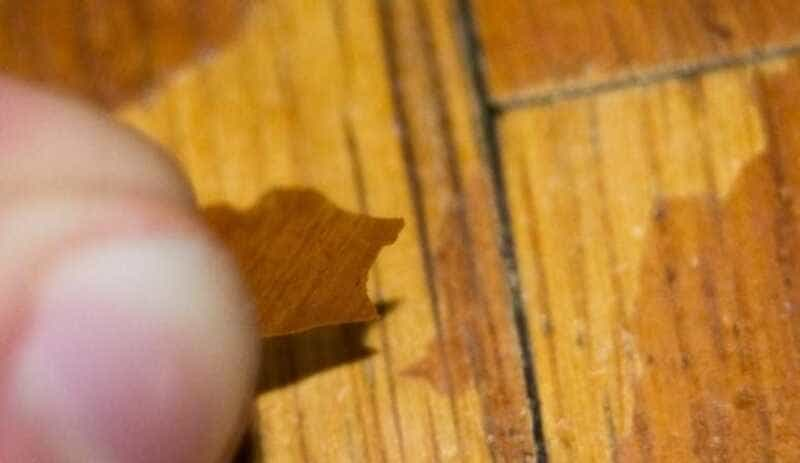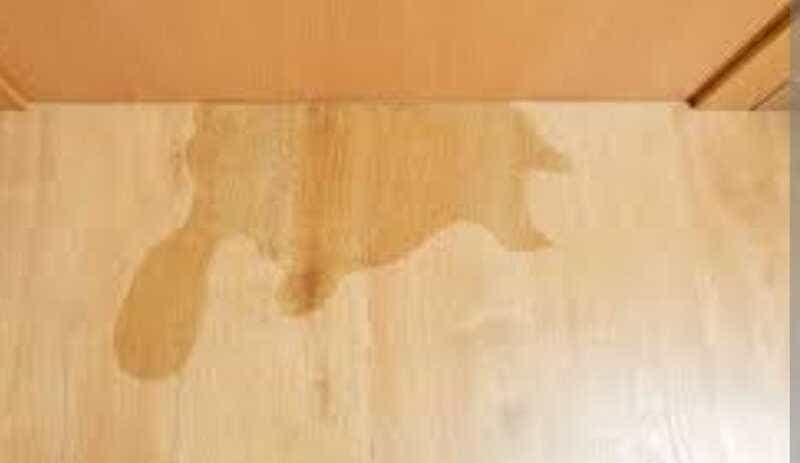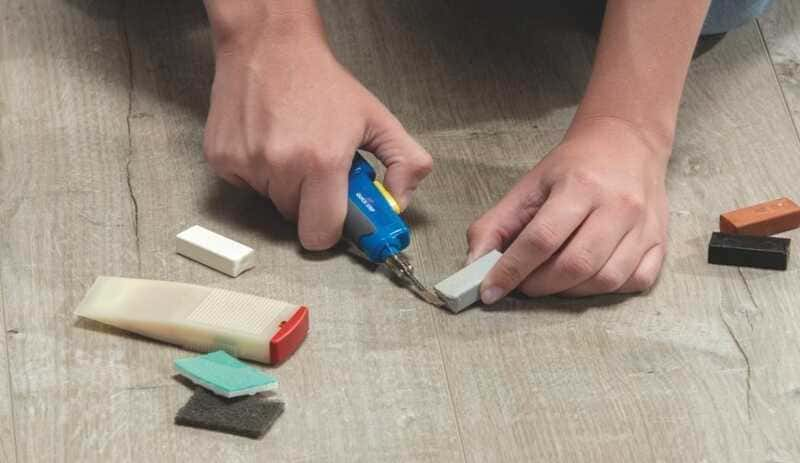Laminate flooring can be an excellent choice for your home because it is strong, durable and easy to maintain. However, despite its strength, this type of flooring can suffer damage over time, such as spalling and scratches. If left unrepaired, a damaged laminate floor can worsen over time and diminish the aesthetic appearance of your home.
Fortunately, the process of how to fix a chipped laminate floor doesn’t have to be a difficult or expensive task. With the right tools and a few helpful tips, you can repair your laminate flooring and restore it to its original appearance.

In this article, we’ll explore how to fix a peeling laminate floor and provide some helpful tips to keep your laminate floor in excellent condition for many years to come.
Why does laminate flooring peel off?
Laminate flooring is a type of floor covering that is composed of several layers, including a wear-resistant top layer, a decorative layer and a bottom layer that provides stability. Although laminate flooring is known to be durable, it can peel over time so it is important to know why laminate flooring peels in order to establish a procedure on how to fix a peeling laminate floor.
There are several reasons why laminate flooring can peel. One of the most common causes is moisture. When laminate flooring is exposed to moisture for an extended period of time, it can begin to swell and warp, which can cause the pieces to peel. Exposure to water can also cause the underlayment’s to disintegrate, which causes the flooring to weaken and wear more easily.

Another reason laminate flooring can flake is normal wear and tear. Constant traffic from people, pets and furniture can cause the floor to wear over time, which can result in peeling or scratching. In addition, the use of abrasive cleaning products or dragging heavy objects across the floor can also damage the top layer of the laminate and cause it to peel.
In some cases, improper installation of laminate flooring can also cause spalling. If the floor is not installed correctly, there may be gaps between the pieces that allow moisture and water to seep in and damage the floor.
How to assess the extent of damage to laminate flooring.
Before you begin repairing a chipped laminate floor, it is important to assess the extent of the damage to determine the best way to address it. Assessing the damage will help you determine if it is a minor problem that can be easily repaired or if a large area of the laminate floor needs to be replaced.
The first stage of the assessment involves carefully inspecting the damaged area. If spalling is visible, it is important to check for any warping, cracking or weakness in the surrounding surface. It is also important to check if there are any layers of the laminate flooring that have peeled away or if there are any pieces of laminate that have lifted.
In addition, it is critical to check the extent of the damage under the laminate flooring. This can be done by carefully lifting the damaged piece of laminate to inspect the bottom layer. If the bottom layer is also damaged, a larger section of the laminate flooring may need to be replaced.

Another important aspect to consider when assessing damage to a laminate floor is the age and overall condition of the floor. If the laminate floor is old or has suffered significant damage in the past, repairing a section of the floor may not be the best solution. In this case, it may be necessary to replace the entire laminate floor to avoid future problems.
Can peeling laminate flooring be repaired?
If your laminate floor has peeling, you may be wondering if it can be repaired. The good news is that in many cases, it is possible to repair peeling laminate flooring and return it to its original condition without having to replace the entire floor.
The type of repair needed will depend on the degree of damage to the laminate floor. If the damage is slight, you may be able to repair it using a laminate floor repair kit, which usually includes a repair putty or paste and a color blending finish. The filler is used to fill the spalled area and the finish is applied to match the color and texture of the surrounding floor.
If the damage is more extensive, you may need to replace a section of the laminate flooring. This may be a little more complicated than simply applying caulk, but it is still a viable repair for many homeowners. To replace a section of laminate flooring, you will need to carefully remove the damaged laminate pieces and replace them with new pieces. It may be necessary to use tools such as a jigsaw or circular saw to cut the laminate pieces to size.
In some cases, the damage to the laminate floor may be so severe that it cannot be repaired. If the floor has been damaged by a flood or other disaster, the entire laminate floor may need to be replaced.
Fortunately, laminate flooring is relatively easy to install, so it can be a manageable DIY task if you are willing to invest a little time and effort.
How to prepare the area before repairing laminate flooring.
Before beginning the task of how to repair peeling laminate flooring, it is important to prepare the area properly. Proper preparation of the area will help ensure that the repair will be done effectively and that the end result will be satisfactory.
First, the area around the damaged laminate floor needs to be cleaned. This will help ensure that the caulk or glue will adhere properly to the floor. Use a broom or vacuum to clean up any dirt, dust or debris in the affected area. Be sure to remove any loose objects, such as nails, staples or screws, to prevent them from causing further damage.
After cleaning the area, it is important to gently sand the surrounding laminate flooring. This will help the filler or glue adhere better to the floor surface. Use fine grit sandpaper to gently sand the floor in the affected area. Be sure to sand smoothly and do not press too hard to avoid damaging the surface of the laminate floor.
If you are replacing a section of laminate flooring, it is important to accurately measure the area that needs replacement. Use a tape measure to measure the length and width of the affected area. Mark the measurements on the back of the new laminate pieces before cutting them to make sure they are cut to the correct size.
Finally, it is important to make sure you have all the materials and tools needed to complete the repair before you begin. Depending on the type of repair you are doing, you may need caulk, laminate flooring glue, a laminate flooring repair kit, new laminate pieces and tools such as a jigsaw or circular saw. Make sure you have everything you need before you start to avoid having to stop the repair midway.

How to match the height of the repaired laminate floor.
When repairing a peeling laminate floor, it may be necessary to match the height of the repaired floor to match the height of the rest of the floor. This is especially important if a section of laminate flooring has been replaced and the new piece is thicker or thinner than the surrounding floor.
One way to match the height of the repaired laminate floor is to lightly sand the surface of the floor. Use a hand sander with fine grit sandpaper and gently sand the floor surface until the height of the repaired area is equal to the height of the surrounding floor. It is important to sand lightly to avoid damaging the surface of the laminate flooring.
Another way to equalize the height of the repaired laminate floor is to use floor leveling putty. Leveling putty can be applied to the floor surface to fill any gaps or voids and level the floor surface. Apply the leveling putty according to the manufacturer’s instructions and allow it to dry completely before lightly sanding the surface.
It may also be helpful to use a laminate flooring repair kit that includes a tool for cutting and sanding the new piece of laminate. These tools can help cut the new piece of laminate to the correct size and gently sand the surface to match the height of the repaired floor to the rest of the floor.
It is important to remember that if the repaired laminate floor is in a high-traffic area, a sealer may be needed to protect the repair. The sealer can help protect the repair from everyday wear and tear and prolong the life of the laminate floor.
How to seal the joints between repaired laminate pieces.
After repairing a peeling laminate floor, it may be necessary to seal the joints between the repaired pieces to prevent moisture or dust from entering. Fortunately, sealing the joints is a relatively simple process that can be done with readily available materials.
First, make sure the floor surface is completely clean and dry before sealing the joints. Use a damp cloth to remove any dust or dirt residue and allow the floor to dry completely.
Next, choose a joint sealer for laminate flooring. There are several types of sealers on the market, such as silicone and acrylic sealers. Read the manufacturer’s instructions to make sure the sealer is suitable for your type of laminate flooring.
Apply the joint sealer to the areas that have been repaired. Use a sealant nozzle to apply an even line of sealant along the joint. It is important to apply an adequate amount of sealant so that the joint is completely sealed.
After applying the sealant, use a damp cloth to wipe any excess sealant from the floor surface. Allow the sealer to dry according to the manufacturer’s instructions.
It is important to remember that the sealer is not a permanent solution and may need to be reapplied over time. Regularly inspect the sealed joints to ensure they are in good condition and reapply sealer as needed.
